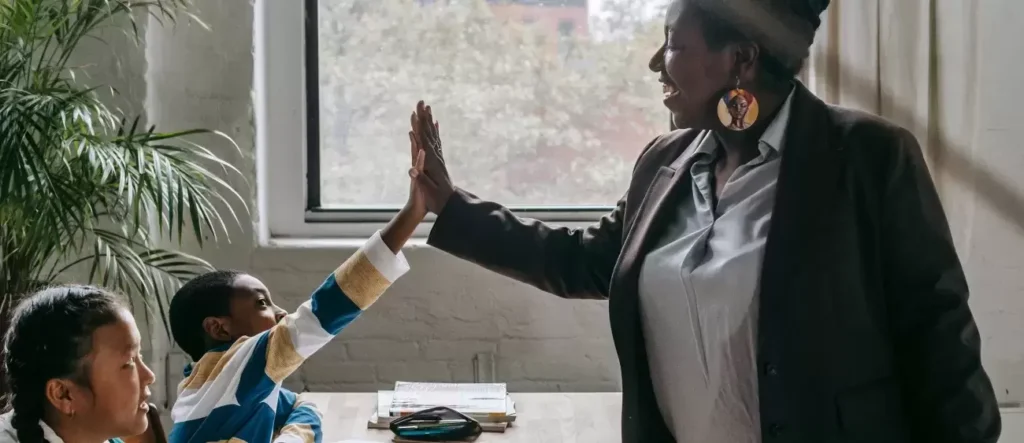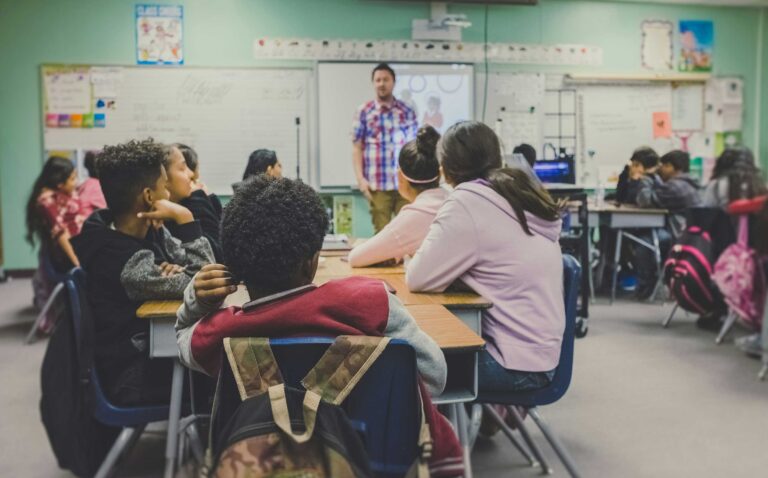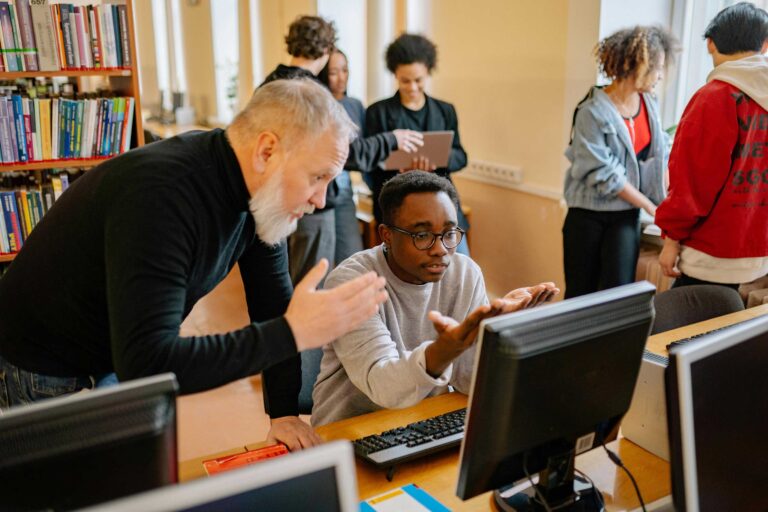Now more than ever, young people need an environment where they feel seen, heard, and valued. Here are some ideas to build this type of culture into your classroom, community center, or other youth-focused setting:
Building trust with youth
Build authentic relationships with youth
Creating connection starts with you, so allow youth to get to know you as a human being in a way that feels comfortable. For example, you can share things about yourself like your favorite hobbies or places to travel. You may also choose to share about your own mental health journey to reduce stigma without sharing triggering details.
Create opportunities for young people to share who they are with you and the group
For example, youth could bring in food from their culture or share a bit about traditions they practice at home. You can also create opportunities for youth to write about themselves, share their hobbies, and discuss their opinions and interests. This fosters a sense of belonging.
Show empathy
When young people come to you with their struggles, validate their feelings and actively listen without judgment or dismissing their concerns. Asking them, “How can I help?” or “What do you need in this moment?” are great ways to show that you care and are there to support them.
Be consistent and stay true to your word
If you say you will do something, even if it seems small to you, make sure to follow through. This teaches young people that they can trust you and that you care about the things they care about. However, if you can’t follow through, be honest. Acknowledge fault, and model for youth how to move forward after making a mistake.
Explain that it’s part of your job to make sure that young people are safe and cared for
Let youth know you are available and open to talking about mental health and other hard topics. It’s also important to let them know that you can help their family find resources if they are having trouble meeting basic needs. Be clear that abuse is never OK, and that you will have to tell others whose job it is to help if a young person is being hurt.
Advocate for young people to get the accommodations they need
Youth with a mental health condition might not realize that they are eligible for academic accommodations. If you can support them and their caregivers in getting these services in place, this can build trust since they can see that you care about them, their learning, and their well-being.
Using trauma-informed practices
Create a predictable routine
Create a predictable routine for your time together. This creates a sense of safety and allows young people to feel more at ease.
Build a social-emotional check-in into your routine
You can do this out loud or at the top of a worksheet. Ask something like, “How are you feeling on a scale from 1 to 5?” or “If your mood were a color today, what would it be and why?”
Provide opportunities for choice when possible
This may not be realistic to do all the time, but allowing young people to choose between different assignments/activities gives them a greater sense of control and agency in their learning.
Be mindful of a curriculum or an activity that might be triggering
Be mindful of a curriculum or an activity that might be triggering for young people in the room. Provide a trigger/content warning or choose a different activity. If you are covering a triggering topic, you could also reach out to your school counselor/social worker to see if they would be willing to be involved in the lessons. Mindfulness activities can be a helpful tool to use before/after these lessons as well so students have the opportunity to decompress and regulate their emotions.
Emphasize the importance of a growth mindset
Emphasize the importance of a growth mindset, reminding youth that when obstacles get in their way, they are capable of learning and growing. Provide genuine positive feedback to the young people you work with that encourages this mindset.
Create opportunities for young people to provide feedback
Create opportunities for young people to provide feedback about the class/club. You could have an anonymous suggestion box, online survey, etc. This can help you better meet the needs of the young people you are working with. It also shows that their opinions matter to you.
Try to determine the reasons behind behaviors
Every behavior communicates a need. Is the student experiencing a difficult time at home? Are they being bullied? Are they feeling hungry, sick, or tired? Try to understand and address the reasons behind the behaviors instead of enforcing punitive measures.
Take care of your own mental health
This may mean creating boundaries around your time, spending time with people you love, working on a hobby, etc. Be sure to eat nutritious food and stay hydrated throughout the day. Take breaks and time off to “refill your cup.” When you feel balanced and healthy, you are more likely to respond to young people in a way that is calm, kind, and supportive of their growth.
Promoting peer support
Provide opportunities for youth to be trained on support strategies
Provide opportunities for youth to be trained on support strategies to help their friends going through mental health challenges. This might look like collaborating with the school nurse, counselor, social worker, or administrators to create programming. You could also use resources and curriculum ideas from mental health organizations like Mental Health America and others. You could invite local nonprofits, businesses, or community leaders to offer resources and educate youth on how to support themselves and their peers.
Organize group discussions about mental health
Be sure to set the ground rules ahead of time for what and how youth will share. (E.g., one person will speak at a time, we will not share details of a story that could be triggering to others, etc.) For more ideas about how to facilitate these discussions, check out our Building classroom relationships and culture factsheet and Classroom Activity guides:
Building relationships within the classroom
Integrating your curriculum with social-emotional learning
Processing a tragedy with youth
Create opportunities for connection and belonging
Create opportunities for connection and belonging through interest-based activities and games. This can look like a sports team, gaming club, art club, improv comedy group, etc. Ask young people what kinds of activities they would like to be involved in. These can take place before/after school, during lunch, or maybe it is even possible for you to teach an elective class students can take during the school day based on a topic of interest.
Supporting youth in crisis
Advocate for training school personnel
Advocate for training school personnel on identifying signs of mental health crises and how to support youth in crisis. You could ask your administration to provide opportunities for professional development around this topic and ask your school counselor/social worker for additional resources and support.
Ensure there is a clear protocol
Ensure there is a clear protocol of what would happen if a young person was in crisis. For example: Who would they see first, what would happen after they saw this person, etc. This makes the situation less stressful for the young person in crisis and the adults supporting them.
Create support systems within the school community
Create support systems within the school community to help youth in crisis access the help they need. Identify the staff and peers whom the young person in crisis feels connected to and trusts. Work with the young person to find out how they think these people can best support them through this difficult time.
Post crisis resources and information in a visible place
Post crisis resources and information in a visible place for youth to access. This ensures that if they do not feel comfortable talking with someone they know, they still know what resources are available to them. You can post these crisis resources, such as:
- Suicide and Crisis Lifeline: Call 988 for support.
- Crisis Text-Line: Text HOME to 741741.
Designing the physical space
Create a “calm space” or “cool down corner”
Create a “calm space” or “cool down corner” young people can go to if they are feeling overwhelmed. This space could include:
- Coloring sheets and colored pencils
- Fidgets, like pop-its or stress balls
- Things that promote movement, like stationary bike pedals that can go under a desk or an inflatable “wiggle cushion” students can sit on
- Writing prompts that ask questions like: “How are you feeling? Why do you think you are feeling this way? What do you need to feel better?”
Fill your space with posters, flags, and books
Fill your space with posters, flags, and books that represent the identities of the young people in the room.
Create flexible seating arrangements
Create flexible seating arrangements that provide accessibility. (For example, providing standing desks can support youth with ADHD, seats located in a place where a young person can see the door and the whole room can support youth with PTSD.)
Use lighting that provides a calm atmosphere
Try using lamps and natural light instead of overhead lighting if possible.
Provide opportunities for young people to take ownership
Provide opportunities for young people to take ownership of the design of the space. (For example, deciding where to put furniture, who will water the plants, etc.)
Youth who feel empowered to support their own mental health and the mental health of others in their community create strong networks of support. When young people’s voices are heard and acknowledged, adults are able to build trust and create safe environments that are relevant to their needs. Find additional information and resources for educators to create safe spaces in schools.
Take a mental health test
 If you or a friend are struggling with your mental health, take an anonymous, free, and private mental health test. It only takes a few minutes, and after you are finished, you will be given information about the next steps you can take based on the results.
If you or a friend are struggling with your mental health, take an anonymous, free, and private mental health test. It only takes a few minutes, and after you are finished, you will be given information about the next steps you can take based on the results.
If you or someone you know is struggling or in crisis, help is available. Call or text 988 or chat 988lifeline.org. You can also reach Crisis Text Line by texting HOME to 741741.


